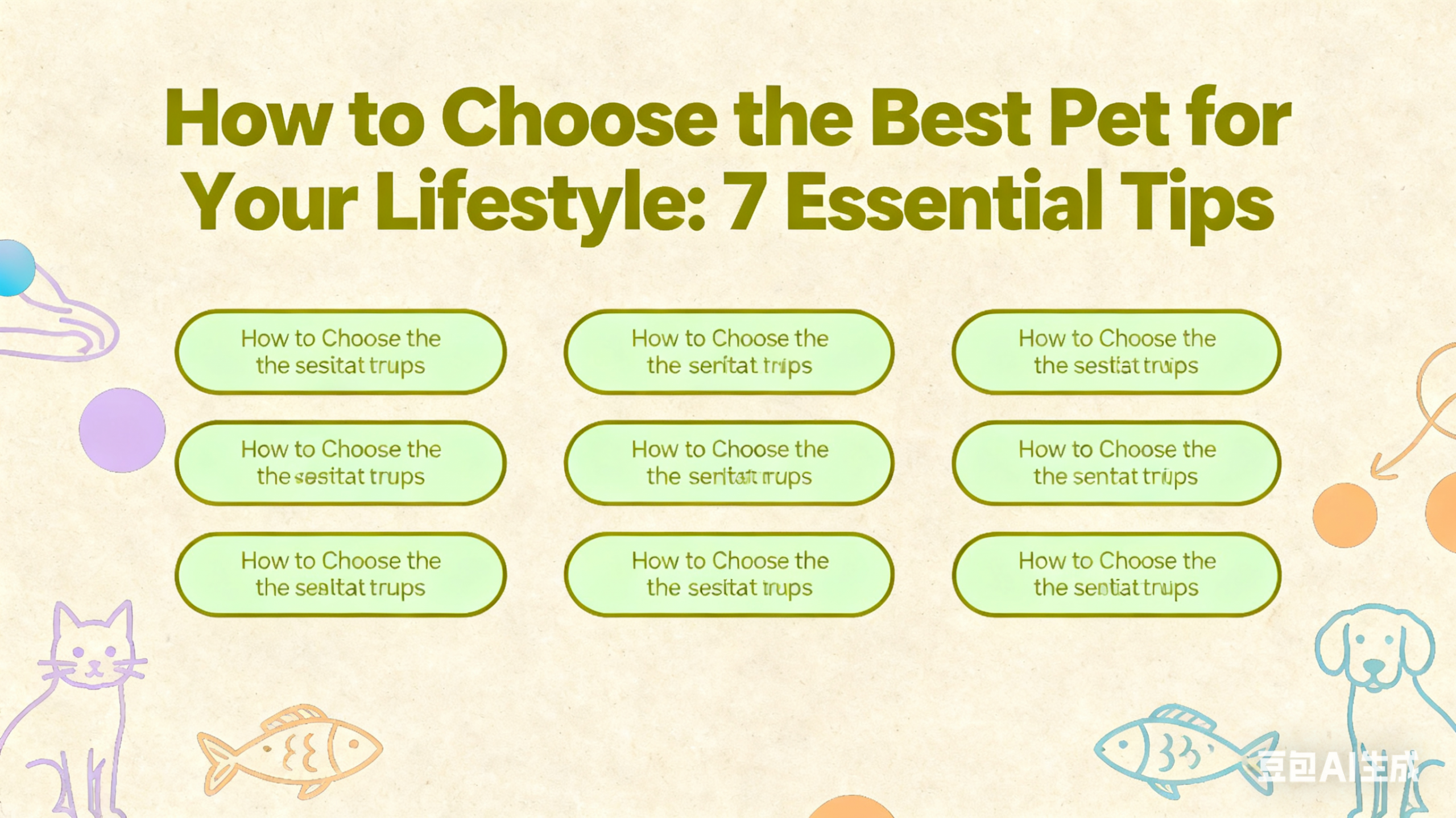How to Choose the Best Pet for Your Lifestyle: 7 Essential Tips (2025)

Table of Contents
- 1. Introduction: Why Choosing the Right Pet Matters
- 2. Tip 1: Align the Pet with Your Lifestyle
- 3. Tip 2: Factor in Your Budget
- 4. Tip 3: Check Your Living Arrangements
- 5. Tip 4: Match Pets to Your Personality
- 6. Tip 5: Assess Your Time Commitment
- 7. Tip 6: Consider Your Pet Care Experience
- 8. Tip 7: Opt for Adoption (When Possible)
- 9. Conclusion: Find Your Perfect Furry (or Scaly!) Companion
Introduction: Why Choosing the Right Pet Matters
For many people, a pet is more than just an animal—it’s a beloved family member that brings joy, companionship, and even stress relief. But choosing the wrong pet can lead to frustration: a high-energy dog stuck in a tiny apartment may become anxious, while a shy cat paired with a busy, outgoing owner might feel neglected. The key to a happy pet-parent bond? Matching the pet’s needs to your unique lifestyle. In this guide, we’ll break down 7 essential tips to help you find a pet that fits seamlessly into your daily routine, budget, and personality.
Tip 1: Align the Pet with Your Lifestyle
Your daily habits and living space are the first clues to the “right” pet. Start by asking: Do you live in a studio apartment or a house with a yard? Are you up for hiking every weekend, or do you prefer cozy nights in?
- Small spaces (apartments/condos): A cat, betta fish, or hamster is ideal. Cats are independent—they use litter boxes, don’t need walks, and thrive even when you’re at work. Fish (like a colorful betta or small community tank) are low-effort, adding calm to your space without taking up much room.
- Houses with yards: If you’re active, consider a Labrador Retriever, Golden Retriever, or Border Collie. These breeds love outdoor play, long walks, and mental stimulation—they’ll keep up with your adventures.
- Low-activity lifestyles: A senior dog (calmer than puppies) or a reptile (like a leopard gecko) works. Senior dogs often prefer napping over zoomies, while reptiles need minimal daily interaction.
Tip 2: Factor in Your Budget
Pets aren’t just “one-time buys”—they require ongoing costs, and overspending can strain your finances. Be realistic about what you can afford:
- Low-budget pets: Fish (tank setup + monthly food = ~$50-$100/year), hamsters (cage + bedding + food = ~$80-$150/year), or budgies (cage + seeds = ~$100-$200/year).
- Mid-budget pets: Cats (food + litter + annual vet visits = ~$500-$800/year) or small dogs (Chihuahuas, Shih Tzus: ~$600-$1,000/year).
- High-budget pets: Large dogs (Labradors, German Shepherds: ~$1,000-$2000/year—more food, bigger vet bills) or exotic pets (birds, reptiles: specialized food/cages = ~$800-$1,500/year).
Don’t forget emergency costs (e.g., a dog’s unexpected surgery could cost $1,000+). Set aside a “pet fund” to avoid last-minute stress.
Tip 3: Check Your Living Arrangements
Before bringing a pet home, make sure your living situation allows it—this avoids heartbreak later.
- Renters: Ask your landlord about pet rules. Many restrict breeds (e.g., no pit bulls, Rottweilers) or charge pet deposits ($200-$500). Some ban pets entirely, so get approval in writing.
- Allergies: If family members are allergic to pet dander, opt for hypoallergenic breeds: Poodles (dogs), Sphynx cats (hairless), or Portuguese Water Dogs. These shed less and produce fewer allergens.
- Multi-pet homes: If you already have a pet, choose a new companion that gets along with them. For example, a calm cat may clash with a hyper puppy—ask a shelter staff for compatibility tips.
Tip 4: Match Pets to Your Personality
Your personality should sync with your pet’s temperament—otherwise, both of you will feel out of place.
- Introverts (quiet, homebodies): Cats, hamsters, or hermit crabs. These pets don’t demand constant attention; a cat will curl up with you while you read, and hamsters entertain themselves with wheels.
- Extroverts (social, active): Dogs (Golden Retrievers, Beagles) or parrots. Dogs love trips to the park and playdates, while parrots thrive on interaction and can even learn to “talk.”
- Organized, detail-oriented people: Reptiles (leopard geckos, bearded dragons) or fish. These pets need consistent care (e.g., tank cleaning, temperature checks)—perfect for those who love routine.
Tip 5: Assess Your Time Commitment
Pets need time—some more than others. Be honest about how much you can dedicate daily:
- Busy schedules (long work hours, frequent travel): Low-maintenance pets. Cats can be left alone for 1-2 days (with food/water auto-dispensers), fish need 10-15 minutes of tank care weekly, and snakes only need feeding every 5-7 days.
- Flexible schedules (work from home, part-time jobs): Dogs (puppies or active breeds) or rabbits. Puppies need potty training and playtime (2+ hours/day), while rabbits need enclosure cleaning and cuddles.
- Frequent travelers: Avoid high-maintenance pets (like puppies or parrots). Instead, choose a pet that a friend/neighbor can check on quickly (e.g., a hamster or betta fish).
Tip 6: Consider Your Pet Care Experience
If you’re new to pet parenthood, start small—don’t jump into a high-responsibility pet.
- First-time owners: Fish (easy to care for, teaches routine), hamsters (small, low-stakes), or adult cats (calmer than kittens). These pets help you learn basics like feeding schedules and minor health checks.
- Experienced owners: Puppies (need training), exotic pets (e.g., sugar gliders, parrots—require specialized care), or multi-pet households. Your past experience will help you handle challenges like potty training or introducing pets.
Even seasoned owners should research specific breeds/species: A Maine Coon cat has different grooming needs than a Siamese, and a Bearded Dragon needs different lighting than a Ball Python.
Tip 7: Opt for Adoption (When Possible)
Millions of pets in shelters across the country need loving homes—and adoption is a win-win: you save a life, and shelters often provide vaccinated, spayed/neutered pets at lower costs than breeders.
- How to adopt wisely: Ask shelter staff about the pet’s history (e.g., “Is this dog good with kids?” “Does this cat like other animals?”). Many shelters offer “meet-and-greets” to test compatibility with your family or existing pets.
- Adoption perks: Shelters often cover initial vet visits, and some even provide starter kits (food, toys, beds)—saving you money upfront.
Conclusion: Find Your Perfect Furry (or Scaly!) Companion
Choosing the right pet isn’t about picking the “cutest” one—it’s about finding a companion whose needs fit your life. By considering your lifestyle, budget, living arrangements, personality, time, and experience, you’ll avoid mismatches and build a lasting bond.
Remember: Owning a pet is a long-term commitment (10+ years for cats/dogs!), but the joy—late-night snuggles, playful zoomies, and unwavering loyalty—is worth it. Whether you bring home a fish, a cat, a dog, or a shelter rescue, the right pet will feel like a missing piece of your family.




Leave a Comment